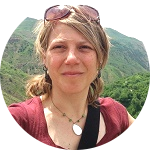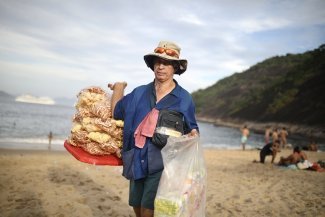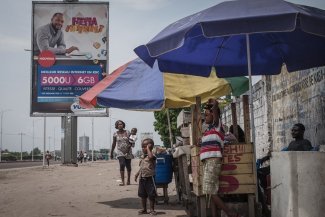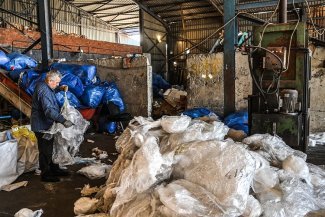The ruined citadel above Hasankeyf is one of the only parts of the town that will remain above the water level of the Ilısu Dam’s reservoir.
For a sleepy hamlet more used to the bleating of livestock, the chirping of birds and the resonant call to prayer, the crashing noises that soundtracked this summer came as a shock. Massive rocks were sheared off the limestone cliffs surrounding the town, filling in caves that date back to the Neolithic era.
“It’s hard. You look left, and they’re digging; you look right, they’re building another road across the river,” says a restaurant worker in Hasankeyf, a small village on the banks of the Tigris River in south-eastern Turkey.
The work going on here is part of a controversial €1.2 billion (US$1.4 billion) dam project that threatens to displace tens of thousands of people across the Tigris Valley and submerge 12,000 years of history in Hasankeyf. With centuries of human habitation spanning various historic periods, the town is believed to meet nine out of 10 criteria for inclusion on UNESCO’s World Heritage List. Although prospective sites only need to meet one criterion, Turkey has never applied for Hasankeyf to be listed.
According to an August 2017 report in the Guardian, “the dam will raise the level of the Tigris at Hasankeyf by 60 metres, submerging 80 per cent of the ancient city and numerous surrounding villages, including more than 300 historical sites that have still not been explored.”
Emblematic of broader political and development trends in Turkey, and enmeshed in regional tensions, its impacts also have the potential to ripple out much further.
With the Ilısu Dam reported to be 95 per cent completed, the readying of Hasankeyf to largely disappear under the waters of its reservoir entered its final phase this year with the collapsing of parts of the cliffs and the moving in May of the 15th century Zeynel Bey Tomb, the first of nine historic monuments scheduled to be relocated to a planned archaeological park. Work is also underway to build new homes on higher ground across the river.
“We are aiming to finish the houses in 2018, and then move the existing Hasankeyf to the new settlement,” Hasankeyf District Governor Faruk Bülent Baygüven told the Turkish press in October. Government officials say the area’s residents will benefit from a boom in tourism once the dam reservoir is filled, citing the potential for boat tours to Hasankeyf’s ancient cliff-top citadel, one of the only parts of the town that will remain above water. Diving trips and visits to the new archaeological park have also been mooted.
“The district will become a centre of both water sports and cultural tourism,” Baygüven said in September, adding that the government “has now started work on aquaculture to provide alternative income for villagers affected by the Ilısu Dam.”
“I will move…I have no other choice”
But many residents remain uncertain about their future in Yeni (New) Hasankeyf. “The new homes may be more comfortable, but I don’t know what I’ll do for work, and the land over there isn’t fertile,” says a father-of-five who would only speak anonymously, like many villagers. “I qualified to buy a new home, so I will move [to the new settlement], but I have no other choice.”
Only about one-third of the approximately 2,000 Hasankeyf residents who applied to purchase homes in the new settlement were deemed qualified. Many say the pay-outs they received from the government for their current houses were under market value, meaning they will have to go into debt to buy the new homes. Renters received no compensation at all.
The size of the plots of land in Yeni Hasankeyf are another concern. Many residents currently provide for their families, at least in part, by growing food and raising livestock – activities they likely won’t have room for around their new homes. Shopkeepers who have been allocated retail spaces in the new settlement wonder how they will make ends meet if forced to move ahead of the town’s residents, as currently seems to be the plan.
No one in Hasankeyf knows precisely where they will live in the new settlement, when they will have to move, what the business conditions will be, or when the promised tourists will start coming. “If you ask local officials anything, they just shrug their shoulders,” one resident says.
Developments in Ilısu village, where the dam is being constructed about 100 kilometres downstream, don’t bode well. “The state built a new village for people, and they moved there, but the houses’ small gardens are not big enough for them to do the agriculture they used to do,” says Ercan Ayboğa, an activist with two groups campaigning against the dam, the Initiative to Keep Hasankeyf Alive and the Mesopotamian Ecology Movement. “Some of them have work on building the dam and related jobs, but they don’t know what kind of income they will have after that work is complete,” he adds. “Everything is unclear, there are no guarantees.”
Small rural villages like Hasankeyf and Ilısu are increasingly endangered in Turkey, where the government has embarked on hundreds of hydropower-generation projects and granted land rights to mining companies using “urgent expropriation” laws, driving migration to larger towns and cities. This has created pressure on urban centres, which are in turn being rapidly redeveloped by mass “urban transformation” projects, and on the natural environment.
Environmental damage and regional instability
In Hasankeyf, gravel is being dug out of the riverbed to use as building material, while new bridges being built across the Tigris to aid construction-vehicle access are affecting the river’s flow. Fish kills have already been reported in the waterway, and environmental campaigners have identified dozens of species, from birds and bats to river fish and an endangered soft-shell turtle, that they say will be impacted by habitat loss when the dam’s reservoir is filled.
There are also potentially devastating effects further downstream, in Iraq. “The salinity level of the Tigris [in Iraq] is already very high, with the water in many places not meeting minimal standards for use in agriculture or as drinking water,” says Ismaeel Dawood, a co-founder of the Save the Tigris and the Iraqi Marshes Campaign. “There is also a water shortage along the Euphrates River course, so the Iraqi government is channelling water from the Tigris to keep the Euphrates alive.”
Restricting flow on the Tigris with a large dam like Ilısu would not only affect the river basin environment, and the livelihoods of people residing along it, it could also contribute to existing instability and tensions in the region, says Dawood.
“There are already internal clashes over water between cities in different governorates, political problems between cities and provinces, even some actual conflict between different tribes,” he says.
“Turks, Kurds, Iraqis and Iranians should all be pressing their governments to use water as a tool for sustainable peace between communities rather than in ways that create conflict. Big dams are a threat to cultural heritage and to peace.”
The Turkish government touts the 3.8 billion kilowatt-hours of electricity the Ilısu Dam will contribute each year to the country’s growing energy needs. But activist Ayboğa claims the economic dimension is only one of many motivations.
“The Ilısu Dam is also important as a potential tool to use against Iraq, to make pressure in an unstable region where relationships can change frequently,” he says. Ayboğa and others also believe that the Turkish government aims to use the dam to help control a restive part of the country. South-eastern Turkey is heavily populated by members of the Kurdish minority and home to both a Kurdish political opposition and an armed insurgency.
Violence in the region has led to multiple waves of displacement over the past 30 years, including in the informal (Turkish) Kurdish capital of Diyarbakır, where vast swathes of the city’s historic Sur district have been expropriated and are undergoing urban transformation following an armed conflict there from late 2015 to early 2016. Local NGOs say they have not been allowed to assess the full damage caused to the neighbourhood’s architectural and cultural heritage by either the violence or the renewal project.
Protests against such developments have been muted under the ongoing state of emergency Turkey declared following a failed coup attempt in July 2016. Since then, demonstrations have been severely restricted, media outlets shut down, and more than 60,000 people arrested on alleged links to the coup, including journalists, human-rights advocates, academics and union activists.
In Hasankeyf, the reluctance to speak out seems borne out of both fear and futility, as the town turns into a construction site in front of residents’ eyes.
In addition to the razed caves, where some families still kept livestock, there is razor wire fencing off parts of the canyons where people picked wild herbs and grazed their animals. A drinking-water spring used for generations has been filled in, and the remnants of a medieval bridge crossing the Tigris encased in stone so it doesn’t fall apart when submerged. With a sense of their final winter in the village approaching, people are cutting down mulberry trees they’ve had in their gardens for years to use as firewood. Any day, they are told, shops on the town’s main market street will be shuttered so preparations can begin to remove the carved stone minaret of the 15th century Rızk Mosque.
“Moving this heritage is just another kind of pressure from the government,” says local shopkeeper Murat Tekin. “Without all these old, historic works, it will not be Hasankeyf anymore.”










